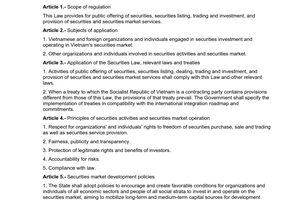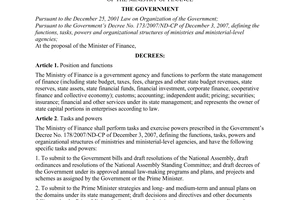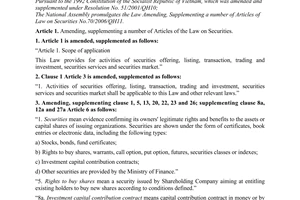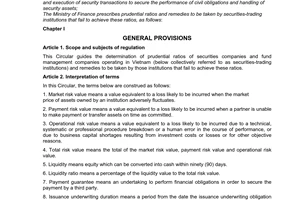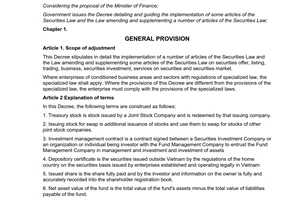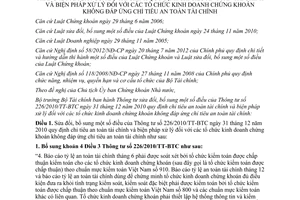Circular No. 165/2012/TT-BTC amending and supplementing a number of articles đã được thay thế bởi Circular 87/2017/TT-BTC actions against securities trading organizations fail achieve prudential indicators và được áp dụng kể từ ngày 10/10/2017.
Nội dung toàn văn Circular No. 165/2012/TT-BTC amending and supplementing a number of articles
|
THE MINISTRY OF FINANCE |
SOCIALIST REPUBLIC OF VIETNAM |
|
No. 165/2012/TT-BTC |
Hanoi, October 09, 2012 |
CIRCULAR
AMENDING AND SUPPLEMENTING A NUMBER OF ARTICLES OF THE CIRCULAR NO. 226/2010/TT-BTC DATED DECEMBER 31, 2010 OF THE MINISTRY OF FINANCE, ON THE PRUDENTIAL RATIO AND THE HANDLING MEASURES FOR THE SECURITIES INSTITUTIONS THAT FAIL TO ACHIEVE THE PRUDENTIAL RATIO
Pursuant to the Law on amending and supplementing a number of articles of the Law on Securities dated November 24, 2010;
Pursuant to the Law on Enterprise dated November 29, 2005;
Pursuant to the Government's Decree No. 58/2012/NĐ-CP dated July 20, 2012, detailing and guiding the implementation of a number of articles of the Law on Securities and the Law on amending and supplementing a number of articles of the Law on Securities;
Pursuant to the Government's Decree No. 118/2008/NĐ-CP dated November 27, 2008, defining the functions, tasks, powers and organizational structure of the Ministry of Finance;
At the proposal of the President of the State Securities Commission,
The Minister of Finance promulgates a Circular to amend and supplement a number of articles of the Circular No. 226/2010/TT-BTC dated December 31, 2010 of the Ministry of Finance, on the prudential ratio and the handling measures for the securities institutions that fail to achieve the prudential ratio;
Article 1. Amending and supplementing a number of articles of the Circular No. 226/2010/TT-BTC dated December 31, 2010 of the Ministry of Finance, on the prudential ratio and the handling measures for the securities institutions that fail to achieve the prudential ratio as follows:
1. Adding Clause 3 to Article 3 of the Circular No. 226/2010/TT-BTC as follows:
“4. The prudential ratio statement of June must be examined by an audit organization permitted to audit securities institutions (hereinafter referred to as a permitted audit organization) under the Vietnam’s Audit Standard No. 910. The prudential ratio statement of December and the prudential ratio statement used for proving that the securities institution is eligible for not being kept under control or special control by a permitted audit organization under the Vietnam’s Audit Standard No. 800, and other relevant Audit Standards. The securities institution must establish an internal control and communication system for recording, monitoring, and updating the financial information and detailed information serving the establishment, examination, and audit of the prudential ratio statements. The Director (management board) of the securities institution must be responsible for establishing and presenting the prudential ratio statement in accordance with this Circular.”
2. Amending Clause 2 to Article 10 of the Circular No. 226/2010/TT-BTC as follows:
“2 The State Securities Commission shall issue warnings and make decisions on putting securities trading institutions under control as prescribed in Article 12 of this Circular, or special control as prescribed in Article 14 of this Circular. Within 24 hours as from making the decision, the State Securities Commission, the Stock Exchange, and the securities institution must disclose this information on their websites.”
3. Amending and supplementing Clause 1 to Article 11 of the Circular No. 226/2010/TT-BTC as follows:
"a) Every month, the securities institution must send the prudential ratio statements to the State Securities Commission under the form prescribed in Annex 5 of this Circular. The statement must be enclosed with a electronic information file within 10 days as from the last day of the month.
b) The securities institution must send the prudential ratio statements of June and December made under Annex 5 of this Circular to the State Securities Commission, and post them on their website, after they have been examined and audited by a permitted audit organization. These statements must be sent to the State Securities Commission and announced simultaneously with the time of disclosing the information about the examined biannual Financial statement and the audited annual Financial statement.”
4. Amending and supplementing Article 12 of the Circular No. 226/2010/TT-BTC as follows:
“1. The State Securities Commission shall make decisions on putting securities institutions under control in the following cases:
a) The liquidity ratio is from 120% to 150% in all the reporting period for 03 consecutive years; or
b) The liquidity ratio examined or audited by a permitted audit organization is from 120% to 150%; or
c) The permitted audit organization gives dissenting or contrary opinions, or does not give any opinion, or fails to give any opinion about the prudential ratio statement, or gives opinions that, the liquidity ratio is from 120% to 150%, if the exceptions are not included in the liquidity,
2. The control period must not exceed 12 months as from the date the securities institution is put under control.
3. The securities institution is released from the control when the liquidity ratio reaches 180% or higher for 03 consecutive months, among which the liquidity ratio at in the last reporting period must be audited by a permitted audit organization.”
5. Amending and supplementing Article 14 of the Circular No. 226/2010/TT-BTC as follows:
“1. The State Securities Commission shall make decisions on putting securities institutions under special control in the following cases:
a) The liquidity ratio is under 120%, including that calculated by the institution itself and that examined or audited by a permitted audit organization; or
b) Failing to rectify the situation that lead to the control within 12 months as prescribed in Clause 2 Article 12 of this Circular; or
c) Failing to make prudential ratio statements in 02 consecutive reporting period, or failing to disclose information about the prudential ratio statements examined or audited by a permitted audit organization as prescribed in Article 11 of this Circular; or
d) The permitted audit organization gives dissenting or contrary opinions, or does not give any opinion, or fails to give any opinion about the prudential ratio statement, or gives opinions that, the liquidity ratio is under 120%, if the exceptions are not included in the liquidity.
2. The special control period must not exceed 04 months as from the date the securities institution is put under special control.
3. The securities institution is released from the special control when the liquidity ratio reaches 180% or higher for 03 consecutive months, among which the liquidity ratio at in the last reporting period must be audited by a permitted audit organization.
4. If the securities institution still fails to rectify the situation that lead to the special control and the gross loss (the undistributed profit on the Balance sheet) reaches 50% of the charter capital or higher, its operation shall be suspended. The procedures for suspending the operation must comply with the guidance from the State Securities Commission, in accordance with the provisions promulgated by the Ministry of Finance.
5. After the end of the period of special control prescribed in Clause 2 this Article, if the securities institution still fails to rectify the situation that leads to the special control, and the gross loss (the undistributed profit in the balance sheet) is under 50% of the charter capital, or fails to settle all debts and other financial obligations as prescribed by law provisions on enterprises and law provisions on bankruptcy, the State Securities Commission shall request the securities institution to suspend its operation.
6. Within 24 hours as from requesting the securities institution to suspended, the State Securities Commission must disclose this information on their website.
7. Within 15 days as from being requested in writing by the State Securities Commission to suspend the operation, the securities institution must disclose the information about the suspension and the issues related to the licensed securities services during the suspension on its website and on the website of the Stock Exchange, and complete the procedures for suspension as prescribed by law provisions on enterprises and law provisions on the establishment, organization, and operation of securities institutions promulgated by the Ministry of Finance.
8. The suspension of the operation of a securities institution prescribed in Clause this Article shall last until:
a) The liquidity ratio of the securities institution satisfies Clause 3 this Article; or
b) The securities institution is merged into or consolidated with another securities institution, or dissolves, or declares bankruptcy as prescribed by law provisions on enterprises and bankruptcy, and the provisions on establishment, organization, and operation of securities institutions promulgated by the Ministry of Finance.
6. Adding Clause 4 to Article 16 of the Circular No. 226/2010/TT-BTC as follows:
“4. During the suspension period prescribed in Clause 5 Article 14 of this Circular:
a) The securities institution must not sign new economic contracts or extend the economic contracts related to the licensed securities services, and must stop other securities services on the following principles:
- For securities companies: must not open transaction accounts for new clients, settle the contracts to provide securities brokerage services (contracts to open securities trading accounts), and transfer the clients’ accounts to a substitute securities company in accordance with the clients’ requests and relevant law provisions (applicable to securities brokerage services), must not provide margin trading services and other financial services related to securities services; must not sign new contracts or expand contracts of investment consultancy (applicable to investment consultancy services); stop the proprietary trading of securities, settle the proprietary trading accounts as guided by the State Securities Commission (applicable to proprietary trading);
- For fund management companies: must not raise capital to create new funds or new securities investment companies; must not increase the charter capital of the fund and investment companies under their management; must not sign new or extend investment management contracts and investment consultancy contracts; must hand over the managerial responsibility and escrow to a substitute fund management company in accordance with the clients’ requests and other relevant law provisions;
b) The securities institution still have to pay outstanding tax and other unsettled financial obligations with the State;
c) For the unexpired contracts signed with clients and employees, the securities institution must keep paying the debts, financial obligations, and fulfilling the commitments and obligations under the terms of the signed contracts, in accordance with civil laws, law provisions on enterprises, law provisions on securities, and other relevant law provisions, unless otherwise agreed by the clients, employees, or creditors; settle the economic contracts right after fulfilling the obligations of the securities institution;
d) The securities institution must keep taking remedial measures as prescribed in Article 13 and Article 15 of this Circular, and complying with law provisions on securities and securities market; ensure the lawful rights and interests of clients and investors as prescribed by law;
dd) The Stock Exchange, the Stock Depository Center shall temporarily annul the membership of the securities institution until the end of the suspension period.
e) The State Securities Commission must not allow the securities institution to expand their scale, add securities services; must not allow the provision of margin trading services and other financial services; must not approve of the investments and transactions that are subject to the approval of the State Securities Commission as prescribed by law on securities and securities market, except for the transfer, consolidation, merger, capital increase, or removal of securities services.”
7. The Annex 5 promulgated together with the Circular No. 226/2010/TT-BTC is superseded by the Annex promulgated together with this Circular.
Article 2. This Circular takes effect on December 01, 2012. The previous provisions that contradict this Circular are all annulled.
Article 3. The amendment and supplementation of this Circular is decided by the Minister of Finance./.
|
|
FOR THE MINISTER |
ANNEX 5
PRUDENTIAL RATIO
STATEMENT
(promulgated together with the Circular No. 165/2012/TT-THE MINISTRY
OF FINANCE, amending and supplementing a number of articles of the Circular No.
226/2010/TT-BTC dated December 31, 2010 of the Ministry of Finance, on the
prudential ratio and the handling measures for the securities institutions that
fail to achieve the prudential ratio)
|
Company’s name:...... Dispatch No. ........... Prudential ratio statement |
SOCIALIST REPUBLIC OF
VIETNAM Location:……………… Date: ……………………. |
To: The State Securities Commission
PRUDENTIAL RATIO STATEMENT
Dated: ……………
We commit that:
(1) The Statement is based on the data updated on the date of making this statement in accordance with the Circular No. 226/2010/TT-BTC dated December 31, 2010 of the Ministry of Finance, on the prudential ratio and the handling measures for the securities institutions that fail to achieve the prudential ratio, and the Circular No. 2012/TT-THE MINISTRY OF FINANCE, amending and supplementing a number of articles of the Circular No. 226/2010/TT-BTC dated December 31, 2010 of the Ministry of Finance, on the prudential ratio and the handling measures for the securities institutions that fail to achieve the prudential ratio;
(2) The issues that might affect the financial condition of the company, which arise after this statement is made, shall be updated in the succeeding statement;
(3) We are responsible before Law for the accuracy of the statement.
|
Chief accountant (Sign with full name) |
Chief of the Internal Control Department (Sign with full name) |
(General) Director (Sign with full name, and stamp) |
I. LIQUIDITY [1]
|
No. |
CONTENT |
LIQUIDITY |
|||
|
Liquidity |
Deductions |
Increases |
|||
|
A |
RESOURCES |
(1) |
(2) |
(3) |
|
|
1 |
Paid-in capital, excluding redeemable preference shares (if any) |
√ |
|
|
|
|
2 |
Share premium, other capital, excluding redeemable preference shares (if any) |
√ |
|
|
|
|
3 |
Treasury stocks |
(√) |
|
|
|
|
4 |
Additional reserve fund of charter capital (if any) |
√ |
|
|
|
|
5 |
Investment and development funds |
√ |
|
|
|
|
6 |
Financial reserve funds |
√ |
|
|
|
|
7 |
Other funds |
√ |
|
|
|
|
8 |
Cumulative profit and undistributed profit before making the reserves as prescribed by law |
√ |
|
|
|
|
9 |
Differences upon asset revaluation (increase by 50% or decrease by 100%) |
√ |
|
|
|
|
10 |
Foreign exchange differences |
√ |
|
|
|
|
11 |
Benefits of minority shareholders[2] |
√ |
|
|
|
|
12 |
Convertible debts |
|
|
√ |
|
|
13 |
Total decrease or increase of securities of financial investment |
|
√ |
√ |
|
|
1A |
Total |
|
|||
|
B |
Short-term assets |
|
|
|
|
|
I |
Cash and cash equivalents |
|
|
|
|
|
II |
Short-term financial investments |
|
|
|
|
|
1. |
Short-term investments |
|
|
|
|
|
|
Securities posing market risks as prescribed in Clause 2 Article 8 |
|
|
|
|
|
Securities deducted from liquidity as prescribed in Clause 5 Article 5 |
|
√ |
|
||
|
2. |
Provision for devaluation of short-term investments |
|
|
|
|
|
III |
Short-term receivables, including receivables from authorization |
|
|
|
|
|
1. |
Receivables from clients |
|
|
|
|
|
|
Receivables from clients which are due within 90 days or less |
|
|
|
|
|
Receivables from clients which are due within more than 90 days |
|
√ |
|
||
|
2. |
Advance payment to suppliers |
|
√ |
|
|
|
3. |
Short-term internal receivables |
|
|
|
|
|
|
Internal receivables which are due within 90 days or less |
|
|
|
|
|
Internal receivables which are due within more than 90. |
|
√ |
|
||
|
4. |
Receivables from securities trading |
|
|
|
|
|
|
Receivables from securities trading which are due within 90 days or less |
|
|
|
|
|
Receivables from securities trading which are due within more than 90. |
|
√ |
|
||
|
5. |
Other receivables |
|
|
|
|
|
|
Other receivables which are due within 90 days or less |
|
|
|
|
|
Other receivables which are due within more than 90. |
|
√ |
|
||
|
6. |
Provision for bad short-term receivables |
|
|
|
|
|
IV |
Inventory |
|
√ |
|
|
|
V |
Other short-term assets |
|
|
|
|
|
1. |
Short-term prepaid expenses |
|
√ |
|
|
|
2. |
VAT deducted |
|
|
|
|
|
3. |
Taxes and payable to state budget |
|
|
|
|
|
4. |
Other short-term assets |
|
|
|
|
|
4.1 |
advances |
|
|
|
|
|
|
Advances that must be returned within 90 days or less |
|
|
|
|
|
Advances that must be returned within more than 90 days |
|
√ |
|
||
|
4.2 |
Other short-term assets |
|
√ |
|
|
|
1B |
Total |
|
|||
|
C |
Long-term assets |
|
|
|
|
|
I |
Long-term receivables, including receivables from authorization |
|
|
|
|
|
1. |
Long-term receivables from clients |
|
|
|
|
|
|
Long-term receivables from clients which are due within 90 days or less |
|
|
|
|
|
Long-term receivables from clients which are due within more than 90 days |
|
√ |
|
||
|
2. |
Capital in affiliated units |
|
√ |
|
|
|
3. |
Long-term internal receivables |
|
|
|
|
|
|
Long-term internal receivables which are due within 90 days or less |
|
|
|
|
|
Long-term internal receivables which are due within more than 90. |
|
√ |
|
||
|
4. |
Other long-term receivables |
|
|
|
|
|
|
Other long-term receivables which are due within 90 days or less |
|
|
|
|
|
Other long-term receivables which are due within more than 90 |
|
√ |
|
||
|
5 |
Provision for bad long-term receivables |
|
|
|
|
|
II |
Fixed assets |
|
√ |
|
|
|
III |
Investment real estate |
|
√ |
|
|
|
IV |
Long-term financial investments |
|
|
|
|
|
1. |
Investment in subsidiaries |
|
√ |
|
|
|
2. |
Investment in associated companies |
|
√ |
|
|
|
3. |
Long-term securities investments |
|
|
|
|
|
|
Securities posing market risks as prescribed in Clause 2 Article 8 |
|
|
|
|
|
Securities deducted from liquidity as prescribed in Clause 5 Article 5 |
|
√ |
|
||
|
4. |
Other long-term investments |
|
√ |
|
|
|
5. |
Provision for devaluation of long-term financial investments |
|
|
|
|
|
V |
Other long-term assets |
|
√ |
|
|
|
|
The assets considers as exceptions in the audited annual financial statement that are not deducted as prescribed in Article 5 |
|
√ |
|
|
|
1C |
Total |
|
|
||
|
LIQUIDITY = 1A-1B-1C |
|
||||
Notes:
1) the entries with “√” must be calculated
2) When calculating the deduction from the liquidity of (B, C), the securities institution may reduce the value of deduction as follows:
- For the assets used as collateral for the obligations of the securities institution or a third party (if the sale contract contains a commitment to buy back, in which the securities institution is the seller), when calculating the deductions, the smallest value of the following values may be reduced: the market value of the asset calculated as prescribed in Annex 2, the book value, and residual of the obligations;
- For the assets guaranteed by client’s assets (such as margin trading contracts, sale contracts that contain commitment to sell back, in which the securities institution is the buyer): when calculating the deductions, the smallest value of the following values may be reduced: the market value of the collateral calculated as prescribed in Clause 6 Article 9, book value.
Among which, the book value is the residual value of the collateral (being a fixed asset) at the time of contract conclusion, or calculated using an internal method of the securities institution at the time of contract conclusion (applicable to other assets).
II RISK VALUE
|
A. MARTKET RISKS |
|||||||||||||||||
|
Investment item |
Risk coefficient |
Scale of risk |
Value of risk |
||||||||||||||
|
(1) |
(2) |
(3)= (1)x(2) |
|||||||||||||||
|
I. Cash and cash equivalents, instruments of the money market |
|
|
|
||||||||||||||
|
1. |
Cash (VND) |
|
|
|
|||||||||||||
|
2. |
Cash equivalents, term deposits |
|
|
|
|||||||||||||
|
3. |
Valuable papers, transferring instruments on the money market, certificates of deposit |
|
|
|
|||||||||||||
|
II. Government bonds |
|
|
|||||||||||||||
|
4. |
Government bonds without interest |
|
|
|
|||||||||||||
|
5. |
Government bonds with coupon payment |
|
|
|
|||||||||||||
|
5.1 |
Government bonds, Government bonds belonging to OECD, or guaranteed by the Governments or Central Banks the countries in this group, bonds issued by international organizations: IBRD, ADB, IADB, AfDB, EIB and EBRD |
|
|
|
|||||||||||||
|
5.2 |
Construction bonds guaranteed by the Government or the Ministry of Finance, of which the residual maturity period is less than 1 year; |
|
|
|
|||||||||||||
|
Construction bonds guaranteed by the Government or the Ministry of Finance, of which the residual maturity period is 1 – 5 years; |
|
|
|
||||||||||||||
|
Construction bonds guaranteed by the Government or the Ministry of Finance, of which the residual maturity period is more than 5 years; |
|
|
|
||||||||||||||
|
III. Corporate bonds |
|
|
|||||||||||||||
|
6. |
Listed bonds of which the residual maturity period is less than 1 year, including convertible bonds |
|
|
|
|||||||||||||
|
Listed bonds of which the maturity period is 1 – 5 years, including convertible bonds |
|
|
|
||||||||||||||
|
Listed bonds of which the maturity period is more than 5 years, including convertible bonds |
|
|
|
||||||||||||||
|
7. |
Unlisted bonds of which the residual maturity period is less than 1 year, including convertible bonds |
|
|
|
|||||||||||||
|
Unlisted bonds of which the maturity period is 1 – 5 years, including convertible bonds |
|
|
|
||||||||||||||
|
Unlisted bonds of which the maturity period is more than 5 years, including convertible bonds |
|
|
|
||||||||||||||
|
IV. Shares |
|||||||||||||||||
|
8. |
Common shares and preference shares listed at the Stock Exchange of Ho Chi Minh city; open fund certificates |
|
|
|
|||||||||||||
|
9. |
Common shares and preference shares listed at the Stock Exchange of Hanoi |
|
|
|
|||||||||||||
|
10. |
Common shares and preference shares of public companies that have not been listed or registered via UpCom system |
|
|
|
|||||||||||||
|
11. |
Common shares and preference shares of public companies that have registered for the depository, but have not been listed or registered to trade; shares of initial public offering |
|
|
|
|||||||||||||
|
12. |
Shares of other public companies |
|
|
|
|||||||||||||
|
V. Certificate of securities investment funds |
|
|
|||||||||||||||
|
13. |
Public funds, including public investment companies |
|
|
|
|||||||||||||
|
14. |
Member funds, separate investment companies |
|
|
|
|||||||||||||
|
VI. Restricted securities |
|
|
|||||||||||||||
|
15. |
Securities suspended from trading |
|
|
|
|||||||||||||
|
16. |
Delisted or canceled securities |
|
|
|
|||||||||||||
|
VII. Other assets |
|||||||||||||||||
|
17. |
Shares, capital contribution, and other kinds of securities |
|
|
|
|||||||||||||
|
18 |
Other investment assets |
|
|
|
|||||||||||||
|
VIII. The additional risk (if any) (based on the liquidity after making all provisions) |
|||||||||||||||||
|
|
Securities code |
Rate of increase |
Scale of risk |
Value of risk |
|||||||||||||
|
1. |
…. |
|
|
|
|||||||||||||
|
2. |
…….. |
|
|
|
|||||||||||||
|
A. TOTAL MARKET RISK VALUE (A= I+II+III+IV+V+VI+VII+VIII) |
|
||||||||||||||||
|
B. A. PAYMENT RISK |
|||||||||||||||||
|
Form of trading |
Value of risk |
Total value of risk |
|||||||||||||||
|
(1) |
(2) |
(3) |
(4) |
(5) |
(6) |
|
|||||||||||
|
I. Risk before the due date |
|||||||||||||||||
|
1. |
Term deposits, loans without collateral, and receivables from the securities trading and securities services. |
|
|
|
|
|
|
|
|||||||||
|
2. |
Given securities loans/economic agreements with the same nature |
|
|
|
|
|
|
|
|||||||||
|
3. |
Taken securities loans/economic agreements with the same nature |
|
|
|
|
|
|
|
|||||||||
|
4. |
Securities trading contracts with commitment to sell back/economic agreements with the same nature |
|
|
|
|
|
|
|
|||||||||
|
5. |
Securities trading contracts with commitment to buy back/economic agreements with the same nature |
|
|
|
|
|
|
|
|||||||||
|
6. |
Contracts to give loans for margin trading(for clients taking loans to buy securities)/economic agreement with the same nature |
|
|
|
|
|
|
|
|||||||||
|
II. Risk after the due date |
|||||||||||||||||
|
|
Overdue period |
Risk coefficient |
Scale of risk |
Value of risk |
|||||||||||||
|
1. |
0 – 15 days after the deadline of payment or securities transfer |
|
|
|
|||||||||||||
|
2. |
16 – 30 days after the deadline of payment or securities transfer |
|
|
|
|||||||||||||
|
3. |
31 – 60 days after the deadline of payment or securities transfer |
|
|
|
|||||||||||||
|
4. |
60 days or more |
|
|
|
|||||||||||||
|
III. Increased risk (if any) |
|||||||||||||||||
|
|
Details of each loan and each partner |
Rate of increase |
Scale of risk |
Value of risk |
|||||||||||||
|
1 |
……. |
|
|
|
|||||||||||||
|
B. Total value of risk of payment (B=I+II+III) |
|
||||||||||||||||
|
C. RISK OF OPERATION (WITHIN 12 MONTHS) |
|||||||||||||||||
|
I. |
Total expenses arising within 12 months |
Value |
|||||||||||||||
|
II. |
Amounts deducted from the total expense 1. Depreciation expenses 2. Provision for devaluation of short-term financial investments 3. Provision for devaluation of long-term financial investments 4. Provision for bad receivables |
|
|||||||||||||||
|
III. |
Total expense after deduction (III = I – II) |
|
|||||||||||||||
|
IV. |
25% of total expense after deduction (IV = 25% III) |
|
|||||||||||||||
|
V. |
20% of legal capital of the securities institution |
|
|||||||||||||||
|
C. TOTAL VALUE OF OPERATION RISK (C=Max {IV, V}) |
|
||||||||||||||||
|
D. Total value of risk (A+B+C) |
|
||||||||||||||||
Notes:
(1): Value of payment risk of the Government and issuing organizations guaranteed by the Government, the Ministry of Finance, the State bank, the Governments and Central Banks of the countries of OECD group; People’s Committees of central-affiliated cities and provinces;
(2): Value of payment risk of the Stock Exchange and the Stock Depository Center
(3) Value of payment risk of credit institutions, credit institutions, and securities institutions established in the countries of OECD group
(4) Value of payment risk of credit institutions, credit institutions, and securities institutions established in the countries of OECD group
(5) Value of payment risk of credit institutions, credit institutions, and securities institutions established and operated in Vietnam
(6): Value of payment risk of other organizations and individuals
III. SUMMARY OF RISK AND LIQUIDITY
|
No. |
ITEM |
Value of risk/liquidity |
Notes (if any) |
|
1. |
Total value of market risk |
|
|
|
2. |
Total value of payment risk |
|
|
|
3. |
Total value of operation risk |
|
|
|
4. |
Total value of risk (4=1+2+3) |
|
|
|
5. |
Liquidity |
|
|
|
6. |
Liquidity ratio (6=5/4) |
|
|
[1] Based on the separate financial statement of the securities institution.
[2] The data in the nearest consolidated financial statement.
------------------------------------------------------------------------------------------------------
This translation is made by LawSoft,
for reference only. LawSoft
is protected by copyright under clause 2, article 14 of the Law on Intellectual Property. LawSoft
always welcome your comments

